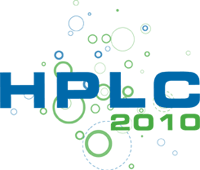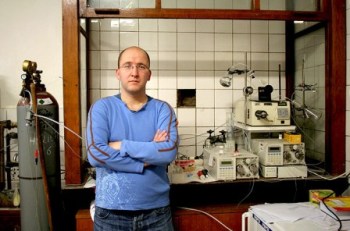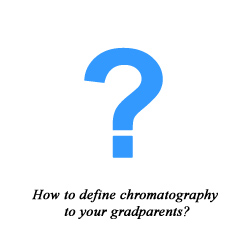 As I mentioned several weeks ago, there was an international symposium on the separation science – HPLC 2010 – held in Boston last week. It was my second North American conference (together with San Francisco 2006) and third in total (plus Stockholm 2005).
As I mentioned several weeks ago, there was an international symposium on the separation science – HPLC 2010 – held in Boston last week. It was my second North American conference (together with San Francisco 2006) and third in total (plus Stockholm 2005).
Allow me to summarize my remarks I made during the lectures I have attended. Fortunately, I have the opportunity to see majority of my pre-selected talks as a volunteer with the microphone in presentation halls.
This post is quite long. However, I didn’t want to chop it in several different posts rather to place all the information together. One more note: your selection (and conclusions) of talks can be completely different, I was mainly visiting sessions focusing on the new columns material, columns characterization and multidimensional techniques as well as monolithic stationary phases.
Sunday
Peter Carr in his plenary lecture awarded with a Martin Gold Medal of The Chromatographic Society described the advantages of the fast second dimension in two-dimensional comprehensive liquid chromatography (2D-LC). He compared time of 2D-LC analysis in 1990 (6 hours) with the current analysis time of twenty-thirty minutes with very fast second dimension (20 seconds!). The combination of perfluorated column together with zirconia type of the stationary phase seems to be satisfactory for several different applications of real samples from corn extract to Starbucks coffee or Minnesota’s red wine.
Short time travel: Peter’s lecture was next day followed by a 2D-LC tutorial led by Dwight R. Stoll. He focused on the necessity of the 2D-LC (is it really necessary and/or better?), column selection for multidimensional techniques and the biggest problem in the field of 2D-LC: lack of 2D instruments with very low gradient delay volume. He also focused on the fraction transfer and second dimension analysis time (why the 20 s looks like good compromise).
In the second plenary lecture, George M. Whitesides describes his efforts in preparation of no or low cost diagnostic tools. Nice talk. Why are we developing separation methods with the highest selectivity, capacity, retention, efficiency … when we are not able to provide their results for majority of people? I am sure symposium such as HPLC (2010) can significantly attribute to discussion like this.
Monday
Nobuo Tanaka introduced next generation of silica-based monolithic columns. Connecting several columns together (1 – 2 m) it is possible to achieve efficiency of several hundreds to million of plates. Moreover, the separation can be done at linear velocity as high as 11mm/s.
My colleague Stuart Chambers talked about the modification of the methacrylate-based monolithic columns with carbon nanotubes or methacrylate modified fullerenes. Surface modification significantly enhanced the column efficiency and values such as 80 000 tp/m for small molecule (benzene) can be achieved using this type of modification.
Ulrich Tallarek described mathematical approach towards the characterization of 3D structure of stationary phases. From my point of view, I am really looking forward to seeing such a model for organic polymer-based monoliths (taking into account their heterogeneity).
Fabrice Gritti discussed why the shell particles are so good and if there is still space for improvement? He described the mass transfer in these particles and compared several different types of the core-shell particles.
Tuesday
Wolfgang Lindner introduced new zwitterionic type of chiral stationary phase which can be used for both weak anion and strong cation exchange chromatography only by tuning the composition of the mobile phase.
Paola Dugo mentioned recent progress in comprehensive LC in the separation of small molecules (flavonoids) as well as larger ones (peptides).
My former boss from Pardubice, Czech Republic Pavel Jandera showed how to optimize gradients in 2D-LC. The gradients in the second dimension can be described as full in fraction (0 – 100%), segment in fraction (x – y%) and continuous shifting with separate run of gradient in second dimension. Optimization of the gradient in second dimension can be described as optimization of three separated steps – isocratic (dwell volume) – gradient – and isocratic again.
Matthew Lindford presented nanodiamond modified stationary phases. The diamond (nanoparticles) was attached to the impervious core using layer by layer addition using polyaminoallyl. These column show enhanced stability, as well as decent efficiency (55 000 tp/m).
Mary Wirth described submicron colloidal crystals nanoparticles packed in capillary format with submicron plate heights. This can be one of the new/next steps in the future of liquid chromatography – packing with ultra small particles and achieving ultrahigh column efficiency. However, the whole process has to be studied more deeply.
Gert Desmed asked where is ultrahigh pressure needed and if. The first part of his talk focused on the application of several connected column to provide the desired efficiency, whereas second one discussed the possibility of the gradients at constant pressure, which significantly speed up the separations (roughly about 10 – 20%).
Susan Olesik presented probably only one talk about the thin layer separations. She described the application of electrospinned polymer as stationary phase in TLC.
Peter Schoenmakers in his first talk (substituing his student Elena) introduced application of regular HPLC column for fast size-exclusion separation of polymers in UPLC mode in less than 1 min. In this case, the extracolumn volumes play very significant role and has to be minimize as much as possible.
Wednesday
Georges Guiochon has begun his talk with historical summary of core-shell type of the particles. Their superior performance is due to the reduced heat effect, short diffusion path and subsequently low contribution of A and C terms of van Deemter equation. The columns are getting smaller and smaller and therefore the role of the instrument is more and more important (why are you using highly efficient column if you are loosing all its performance in the extracolumn connections?). On the end of his talk Georges Guiochon pointed out the importance of column packing method and its quality.
Magdalena Titrici showed the possibility of the surface modification with either NIPAM or PEG-methacrylate based monomer to achieve a thermoresponsive stationary phase. With this kind of polymers the surface can be changed from highly hydrophilic to hydrophobic one.
I missed the beginning of talk of Marja-Liisa Riekkola, however on the very end of her talk she spoke about the capillary packed with very low density lipoproteins (VLDL) “particles”. I have to check this idea again because it looks very originally.
Jesse Omamogho described the new types of core-shell particles prepared using the seeded growth method. Using this technique they are able to control both the diameter of inner core as well as the thickness of the porous layer independently. The pore size of the particles is about 90 A with surface area from 80 to 200 m2/g. On the very end of the HPLC symposium, this talk won a first prize of the Csaba Horvath Award.
Charles Lucy discussed the influence of the stationary phase hydrophilicity on the retention and selectivity of the inorganic ions.
Uwe Neue described the selectivity of the new type of the stationary phases with controlled surface charge. He introduced plots/ways how to characterize column selectivity and how to compare it with other types of the columns.
James Jorgenson, father of ultra high pressure chromatography, spoke about the columns packed with 1 – 1.5 porous and non porous particles used at very high pressure. He studied the influence of the packing slurry solvent on the quality of the column. In the following discussion, Georges Guiochon compared chromatographic particle to the city: there are cities with a lot of gates and streets which make them very easy to enter. On the other hand, there are towns with only one gate and main street. Those are difficult to enter. The particles inside the column have a same “behavior” – either it is easy to enter them (core-shell) or it is difficult (e.g. fully porous).
Anthony Edge described the usage of graphitic column at high temperature with water as mobile phase.
David McCalley focused on the relationship between the applied pressure and compound retention together with molecular structure. Main influence of the analysis pressure on the retention can be observed for ionizable compounds.
Tivadar Farkas compared the influence of the extracolumn volume on the chromatographic behavior of core-shell highly efficient columns. He claimed that with current instrumentation we are not able to fully exploit potential of such columns.
Thursday
Kazuki Nakanishi described the preparation of silica-based monoliths with improved homogeneity of stationary phases enabling high efficient separations at low back pressure. Columns prepared according a new protocol contain only 5% of solid material. However, the disadvantage is their mechanical stability. Such column can be applied either in solid phase extraction or bioreactors.
Emily Hilder presented monoliths in planar format for dried blood spot sampling.
Brett Paul introduced the organic polymer monoliths prepared inside a 1 mm ID titan tubing. He described optimization of preparation together with first results. The column provide efficiency of 50 000 tp/m. Such column can be used at high analysis temperature, e.g. 180 °C.
Peter Schoenmakers continued with the ultra pressure size-exclusion chromatography topic. He focused on the degradation of very large polystyrene standards (> 7 MDa) at ultra high pressure. Further, he described separation of branched polymers using molecular topology fraction inside the monolithic stationary phases with very narrow flow-through pores. Peter correctly pointed out selectivity is one of the main property we should focus on. With very high and specific selectivity it is not necessary to require high efficiency, especially in case of very specific and tailored separations.
Robert Kennedy described in his plenary lecture segmented flow methods for hyphenation of LC and detection techniques, as well as their application in sample handling and tailored injection.
My current boss Frantisek Svec summarized the work of our group. He mentioned hypercrosslinking modification of organic polymer-based monoliths suitable for separation of small molecules (my work), as well as results of my colleagues with modification of the monolithic surface with carbon nanotubes (Stuart Chambers), gold (Yan Xu) and hydroxyapatite (Jana Krenkova) nanoparticles.
Atilla Felinger focused on the description of the thernodynamics and kinetics of solute transfer in HPLC. His very last talk at HPLC 2010 was “spiced” with the sudden technical problem with microphone. Fortunately, the organization team worked quickly and efficiently. As a very good chromatographic column ;-)
Conclusions
So, there are my HPLC 2010 flashbacks. In summary, my feelings are that the future of HPLC separation lies between superficially porous core-shell particles for fast and highly efficient separations and multidimensional techniques for complex samples. The monolithic stationary phases can still play significant role, especially 2nd generation of monoliths with tailored surface modification providing high selectivity for compound(s) of interest. Due to their thermal stability they can be also used at very high temperatures.
I would be more than happy to read your opinion either about HPLC 2010 or my notes.
Thanks for reading.
PS: and as a very last note: the poster of my wife about pressurized electrochromatography and electrophoresis on the thin layer monolithic plates for separation of peptides and oligonucleotides was awarded with the first prize in poster competition.


